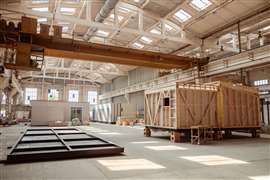Read this article in Français Deutsch Italiano Português Español
Five takeaways on decarbonisation in construction
02 July 2025
PwC’s (PricewaterhouseCoopers) second annual State of Decarbonization report warns that contractors face mounting pressure from clients, investors and insurers to prove carbon performance.
 Cover image for PwC’s “State of Decarbonization” report. (Image courtesy PwC)
Cover image for PwC’s “State of Decarbonization” report. (Image courtesy PwC)
The report pulls survey data and analysis from more than 500 global companies, including detailed breakdowns of construction’s emissions challenges and opportunities.
Mike Sobolewski – PwC assurance partner and US engineering and construction specialist – tells Construction Briefing that firms unprepared risk being shut out of future work.
But what can contractors do today to prevent falling behind tomorrow?
1) Make Scope 3 emissions visible and influence suppliers
 Mike Sobolewski, PwC
Mike Sobolewski, PwC
Scope 3 emissions – those tied to suppliers, materials, and subcontractors – make up more than 70% of a typical construction project’s footprint. PwC’s report breaks this down further: 65% of emissions sit upstream with suppliers and materials, and another 12% downstream with end-of-life and use-phase impacts.
“Embedding emissions into procurement isn’t a moonshot,” says Sobolewski. “It’s a measurable first-mover advantage that protects supply continuity and keeps you in the running when clients ask for accountability.”
In the US market, 54% of construction and engineering firms now report being on track to meet Scope 3 goals, up from 41% the previous year. Yet, PwC says only 1% of surveyed firms have taken clear leadership in engaging suppliers on carbon. Without influencing those inputs, construction firms have little control over the bulk of their carbon footprint, making reductions more difficult.
The bright side: with such little current engagement, there could be a big swing if contractors can influence their suppliers to reduce Scope 3 emissions. And PwC projects that climate-aligned revenue will reach 42% by 2030 for the construction sector, underscoring supplier influence as a clear market opportunity.
PwC’s advice is to start simple: add emissions standards to supplier scorecards and subcontractor prequals and engage regularly with both.
And the narrative does not have to be entirely about the environment. Sobolewski urges firms to treat Scope 3 engagement as a supply chain issue as much as a climate one.
“These steps are not simply about climate, they directly contribute to supply chain resilience and business continuity in increasingly carbon-sensitive markets,” he says.
2) Secure prefab partnerships early
 An off-site prefabrication building site. (Image: Adobe Stock)
An off-site prefabrication building site. (Image: Adobe Stock)
Modular and offsite prefabrication methods are essential for sectors like power, renewables, and digital infrastructure, but global modular/prefab capacity remains limited, with demand outpacing supply and scale in many regions, PwC states. For contractors, not having the right modular or prefab specialist booked well in advance could lead to delays or change orders.
While prefabricating elements offsite can be a time, labour, and monetary saver, delays or rework of prefab materials can be equally costly. The ecosystem of modular and prefab specialists, too, is in flux. Several modular-focused firms have lost their footing in recent years; US-based Katerra and UK-based Ilke Homes shuttered amid a market unsupportive of attempts to scale.
Without access to firms capable of handling prefab workflows, PwC reports that even in fast-moving regions like the Middle East megaprojects are outpacing prefab supply. PwC highlights this trend in other regions, noting limited fabrication networks, labour gaps, and constrained logistics in North America and Africa. At the same time, only 25% of construction firms currently allocate capital expenditure to climate-transition projects, which may explain why prefab capacity and innovation remain slow to scale.
“Modular is now mission-critical for delivering complex, congested, or labour-limited jobs,” says Sobolewski. “But capacity won’t appear overnight. If contractors don’t invest in it, or secure it early, they’ll fall behind.”
3) Run LCAs and EPDs from day one
Design decisions made in the first 10% of a project lock in most of its emissions, PwC says.
Yet, many firms delay lifecycle analysis (LCA) and material assessments until it’s too late to change course.
“Projects that succeed embed lifecycle thinking into the delivery model from day one,” Sobolewski says.
That means using LCA, environmental product declarations (EPDs), and early trade engagement through progressive design-build or integrated project delivery.
In Europe, tools like Indicate Life are gaining ground. A digital tool developed by the European Union’s executive branch (European Commission) to help assess and compare the whole-life carbon impact of construction projects, Indicate Life allows designers, contractors, and regulators to model emissions across all phases of a building’s life from materials and construction to use and eventual demolition, helping guide more sustainable design and procurement decisions.
In the US, a regulatory landscape promoting LCAs and EPDs lags behind the EU, but the financial case for LCAs and EPDs is building, and a host of private-sector and public companies are developing products specifically for the industry. Most large contractors now use them to manage material choices, supply chain impacts, and transport-related emissions. Not using LCA/EPD solutions in some cases could be costly, as incorrect materials choices made in preconstruction can be expensive to replace during the build.
PwC’s report links improved uptake of early design-phase carbon tools to progress in Scope 1 and 2 emissions: 66% of construction companies now report being on track to meet those targets, up from 57% the previous year.
While US federal policy has offered incentives and broad targets, most decarbonisation requirements around materials, emissions, and reporting are driven at the state and municipal level, meaning it’s not just the largest firms subject to carbon emission expectations.
4) Power the whole site or forget electric equipment
 A charging station provides power to a Volve CE EC230 excavator. (Image: Allye)
A charging station provides power to a Volve CE EC230 excavator. (Image: Allye)
Electrified fleets are advancing quickly, but most sites aren’t ready. PwC notes that only 3% of construction’s recent emissions reductions came from renewable electricity, highlighting just how limited electrification still is on job sites today.
PwC says inconsistent charging, weak leasing options, and fragmented logistics make it hard to scale, and some contractors wishing to be early-adopters of electric machines can find themselves in costly predicaments when access to electricity is limited.
“The constraint isn’t innovation, it’s implementation,” Sobolewski explains.
That may soon shift. In some markets, low-emissions fleets are now a bidding requirement, and development of battery electric storage systems is improving and becoming more accessible and affordable.
Contractors that invest in electrification logistics – for the entire site, not just their fleet – may now hold the edge when emissions requirements tighten, PwC says.
Sobolewski explains, “Without site-installed logistics and reliable power infrastructure, electrification remains a marginal business case and may not make it into tomorrow’s bids.”
5) Follow the capital: It’s moving faster than policy
Developers, investors, and insurers are favouring firms that can quantify carbon, verify supplier data, and avoid delays. This trio has been the main driver of decarbonisation, particularly in the US, where deregulation of environmental protections has characterised the Trump administration.
“Capital flows are increasingly driven by private investment,” Sobolewski notes. “Policy still matters, but viability is now tied to delivery reliability, emissions transparency, and speed-to-market.”
PwC reports that modular builds, emissions tracking, and electrification are now considered de-risking moves. If contractors ignore them, it may become difficult for the project to secure funding or insurance, based on today’s expectations.
The report also finds that LEED-certified buildings command a 4% rent premium on average and that the global green building materials market is growing at a 12% compound annual growth rate, which reinforces the commercial logic behind decarbonisation strategies.
The decarbonisation endgame for construction
The bid game is changing, with Scope 3 clarity, prefab planning, and lifecycle tools becoming standard and part of the price of entry, especially on larger public-works projects and multi-family housing. The endgame theory for the built environment: there is no end; carbon reduction is here to stay and, if implemented correctly, can offer revenue growth opportunities.
That means contractors don’t need to (and assuredly should not) wait on regulation to start decarbonising their operations. Falling too far behind mounting expectations now could be detrimental in the future.
“The real risk isn’t a lack of interest,” Sobolewski says. “It’s being unprepared to deliver.”
STAY CONNECTED


Receive the information you need when you need it through our world-leading magazines, newsletters and daily briefings.
CONNECT WITH THE TEAM













